A tenacious, oft-snarling carnivore that digs its terrified prey right out of their subterranean homes.
And that is also occasionally mistaken for a lost footstool.
Yes, that's right - the American Badger.
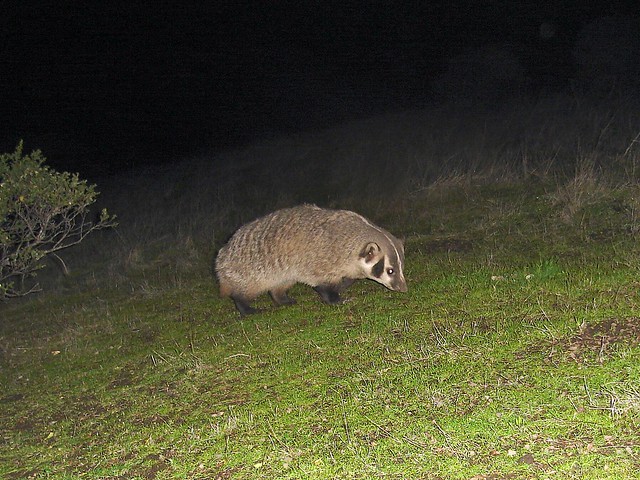
Badger or footstool?
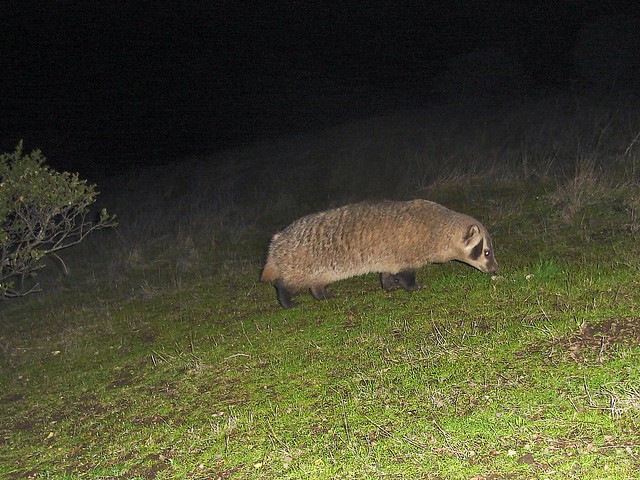
Oh - it moved, must be a badger
They roam the interconnected grasslands and adjoining open woodlands of the Santa Cruz Mountains in San Mateo County, from Half Moon Bay to Pescadero and Ano Nuevo Point, and up and over Skyline Boulevard near Windy Hill and Russian Ridge.
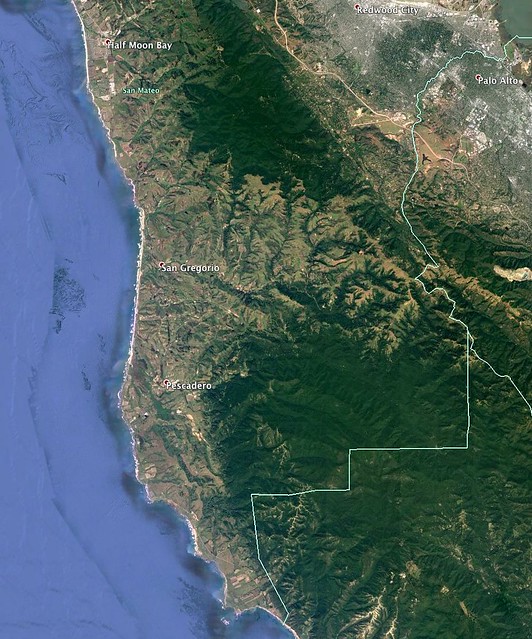
Aerial of the grassland "badger belt" of San Mateo County
And my roaming and camera trapping has overlapped with the home ranges of a handful or two.
But I'm not the first. Post-Grinnell, one of the finest research projects on badgers in the Bay Area was done by Chris Lay, the gregarious Director of UC Santa Cruz's Norris Center for Natural History, as part of his Masters in Biology from San Jose State University.
Chris Lay, SJSU - The status of the American Badger in the San Francisco Bay Area (2008)
I found it immensely useful, and often felt I like was walking in Chris' footsteps.
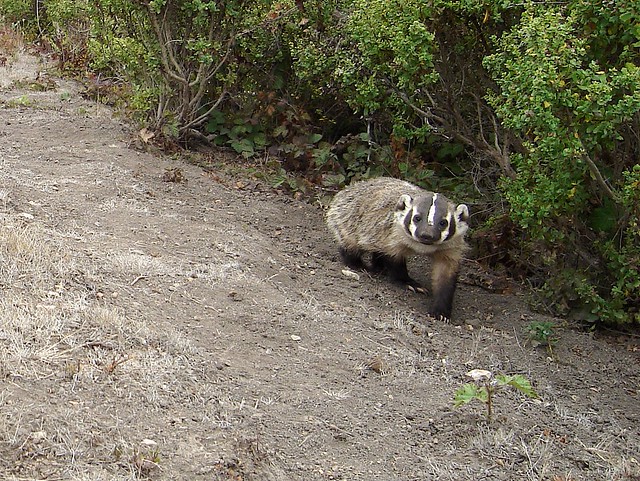
Badger walking a scurry zone
Why are badgers seldom seen? Like mountain lions, badgers are mainly nocturnal, have large home ranges (thousands of acres), live in low densities (a male and a few females will overlap), and mostly live life alone and on the leg - moving frequently to hunt the constantly-replenishing rodents of the connected grasslands of their range.
Making tracking and camera trapping two of the better ways to understand how they might be living on a piece of land.
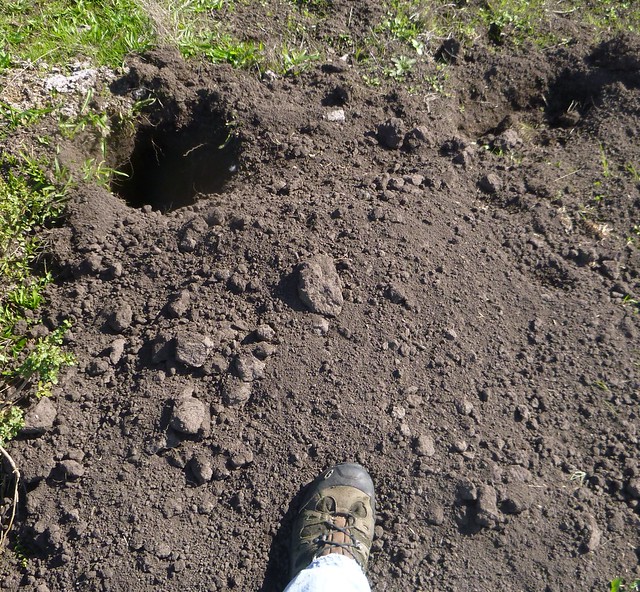
Badger digs with my size 13 boot for size comparison
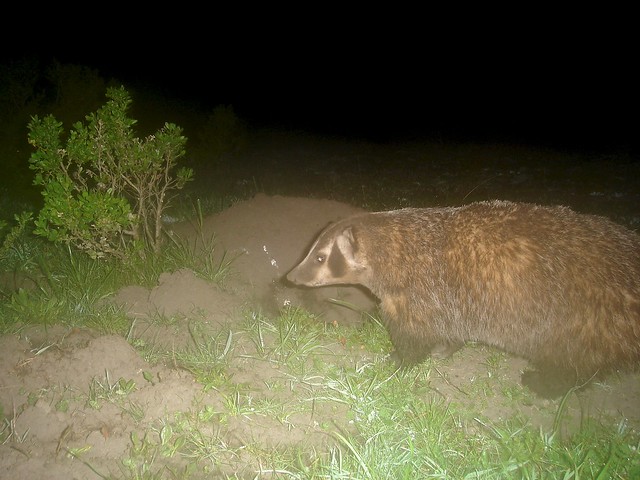
The digger - in fog
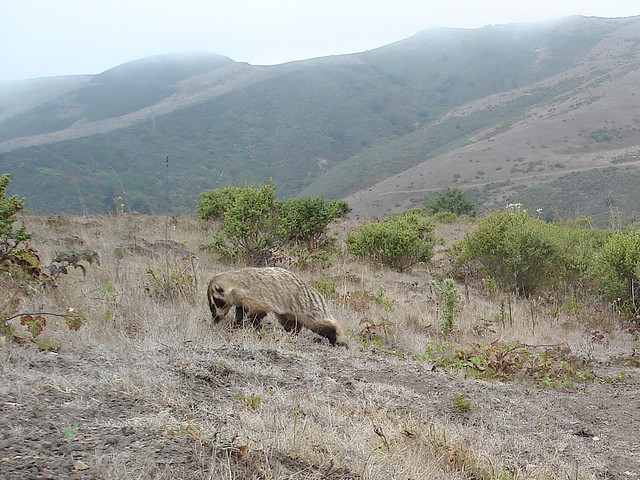
Badger on the hunt with nose to the ground
Along with ground squirrels and gophers, badgers also eat crickets, grasshoppers, beetles, mice, and even rabbits that they often catch when the animals move into their old dead-end burrows.
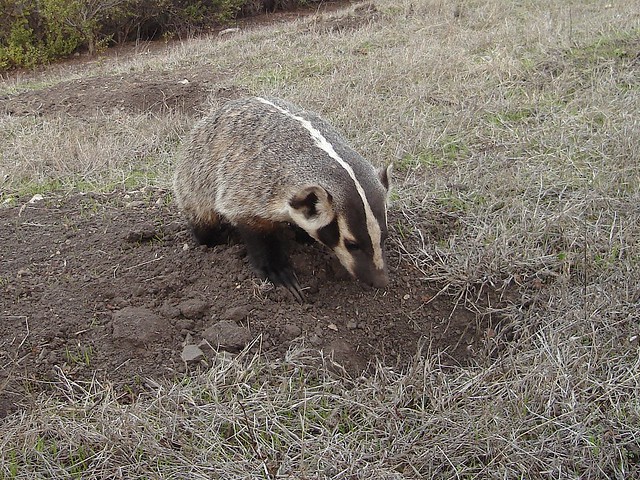
Badger hoping to get lucky by checking an old burrow
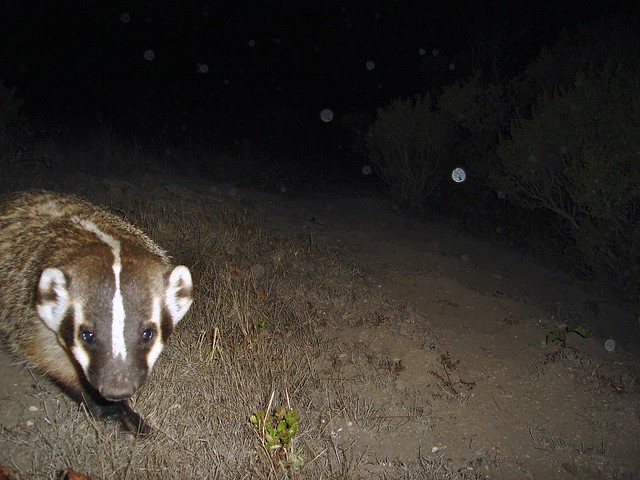
Inspecting a cam trap
A badger's "badge" is the white stripe up the center of their face. As you can see in these photos, it can be a useful character to help distinguish individuals. Like a tiger's stripes or leopard's spots.
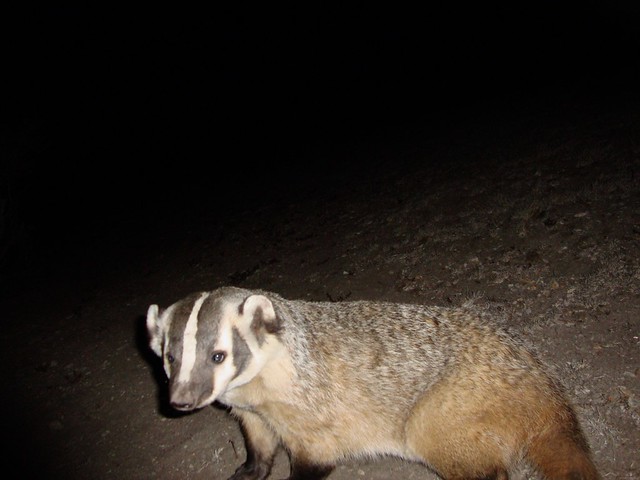
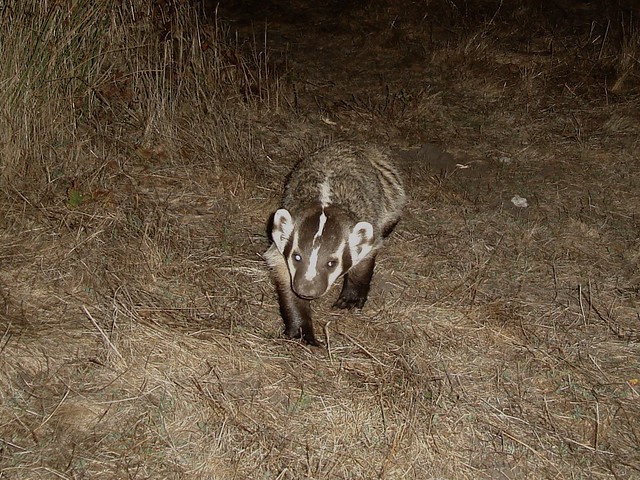
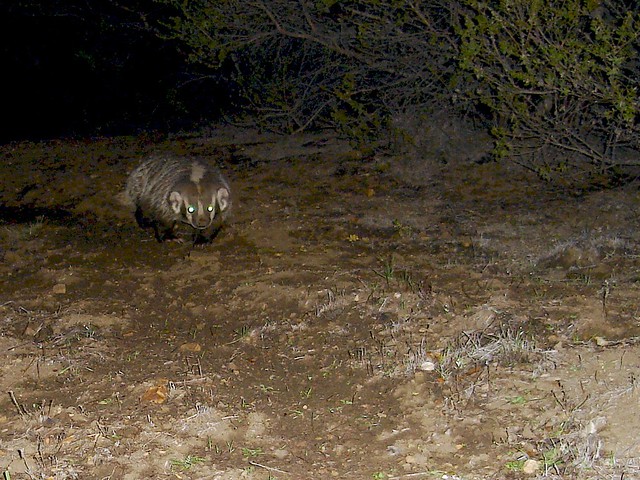
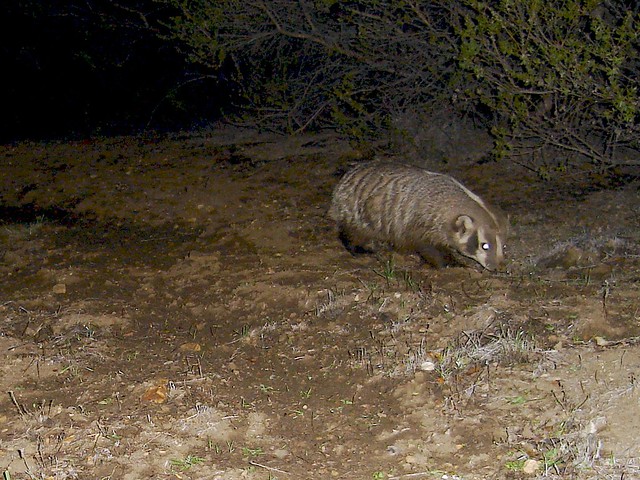
Here's what badger butt looks like. Such a funny after-thought of a tail.
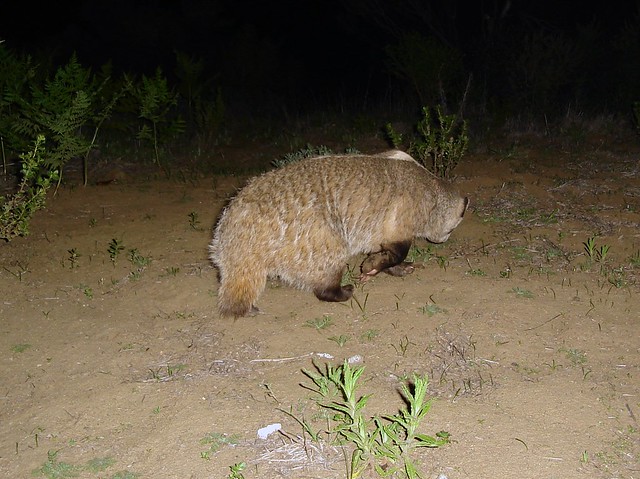
Badger butt and tail
As mentioned, badgers are sometimes mistaken for footstools. So, if you see a footstool crossing the road, please don't hit it. And I wouldn't recommend putting your feet up on it either.
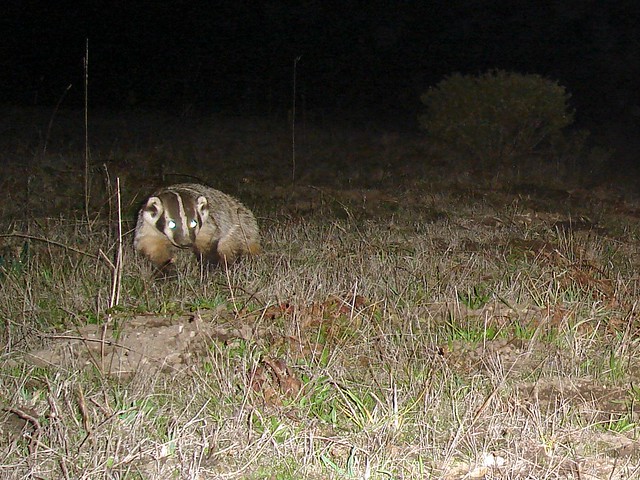
====
References:
- Chris Lay, SJSU - The status of the American Badger in the San Francisco Bay Area
- E. W. Jameson, Jr., and Hans J. Peeters, UCPress - Mammals of California
- Feldhamer, Thompson, Chapman - Wild Mammals of North America
- Wikipedia - American Badger
- Nature of a Man (this blog) - Badger, Badger, Badger, Badger

In six plus California decades, have only ever seen badger holes ... never the critter himself. Thank you for these great pictures.
ReplyDeleteMushroom! Mushroom!
ReplyDeleteSnake!
DeleteGreat to find badgers this morning! I like them. I know they're mainly nocturnal yet I've seen quite a few over the years--including one crossing a road. My favorite was a badger cruising along and investigating the top of rim rock while i was looking for rare plants nearby. btw, to me they look like self-propelled giant bedroom slippers.
ReplyDeleteThat ended up being quite a few badger pictures. Congrats man. That little one is pretty cute. Glad to see a healthy population.
ReplyDeleteGreat to see all the unique badge markings. Still waiting to see or camera trap a live badger myself. Unfortunately, I've seen two dead ones. Impressive claws on them even when they have died.
ReplyDeleteNice photos; wish we had such interesting animals here, just not enough native grassland habitat.
ReplyDeleteI love the photo of the Badger on the slope during the day with his nose to the ground.
ReplyDeleteHow do you tell a badger dig from a coyote dig?
ReplyDeleteHey John. There are several tells to look for in differentiating a coyote (dog) dig from a badger dig. Coyotes dig dog-paddle style, so the dirt bib generally goes straight back from the hole. They also don't have big claws like a badger, so the dirt that comes out is usually in small chunks. Badgers dig to their sides, so the bib will be more sprayed. They also have huge claws that allow them to dig out large clods, rocks and like, and you can often see their claw marks on the sides of the inside of the burrow/dig. The badger holes will tend to be bigger, deeper too (esp. when they go underground), whereas a coyote dig will typically be about as deep as its head. Last, the # of digs in an area is a good clue as well. Badgers are all about digging, so where you find 1 dig you'll usually find many others nearby.
DeleteThanks. I'll be looking for those signs next time I'm out.
DeleteAwesome photos and information. Like many of the others, still waiting to see a badger in the Bay Area. I was lucky enough, long ago, to see one at night in Malheur National Wildlife Refuge. Will be sharing this via @sfbaywildlife.
ReplyDeleteHi, I tried to leave a comment earlier, but this format is a little new for me. Thanks to Ameet for sharing the link to this blog post with me. I sent an email to randomtruth at the designated address.
DeleteThese photos reflect a young badger, I estimate about 1 year of age. This carries with it a few additional considerations. The primary prey for badgers in the South Bay is ground squirrels - and in the North Bay, along with the South Bay where available pocket gophers and meadow voles. This little badger moving along and being photographed through a camera trap is in the process of surviving on its own. The first year of life into year two, based on my experience, is critical for development of digging/foraging skills and ranging safely. The range reflected on your map seems a little large (the ranges for badgers these days are much less than published in prior texts - e.g., the largest range in the entirety of Sonoma County is 8 miles), but that would appear to be an ideal possible range if all lands were connected and there was an ability to range in that way. More likely to be 4 miles or thereabouts. Susan Kirks, Naturalist, susankirks@sbcglobal.net, 707-241-5548
Thanks Ameet, Susan.
DeleteAmeet, seeing badgers in San Mateo County and the Santa Cruz Mtns is tough. There aren't big, open, flat areas, the grasses tend to be tall, and the badgers tend to be thinly distributed and quite nocturnal. In my experience, the best place to see badgers in CA is the Carrizo Plain, where you can see long distances with binocs on gray days. Plus, you can see kit foxes too. :)
Susan, as mentioned in my email, this blog post is pretty light on data, but these photos are from multiple properties across that "badger belt," and include 4-5 different badgers that were documented during formal surveys. The badger location data has been submitted to the CNDDB if you want to look it up.
Thanks for the reminder about Carrizo Plain - it has been on the to do list but will really try and make it this year. Kit Fox is high on the wish list too!
DeleteNo prob Ameet. Hit the side roads off Soda Lake Road, like Bitterwater, and you may also see Pronghorn. And look for Tule Elk on the hills above the big soda lake.
DeleteThanks for the reference to CNDDB (and for submitting that) - will definitely review. My primary focus has been in the North Bay of the Bay Area, documenting habitat and species sightings. The open grasslands of South Sonoma County and West Sonoma County, Sonoma coast and similarly Marin County and Marin Coast are longstanding habitat areas - and 3 wildlife corridors. Enjoyed our email exchange thus far as well. When I receive reports of sightings from the East Bay, I may pass them along, in the hope this info may be useful for your effort.
DeleteAfter 35 years living in the Santa Cruz Mtns the only badger I've ever seen in the wild was out in Idaho. Thanks for these!
ReplyDeleteThese are really wonderful photos. Last summer, I tried to camera trap badgers in the sand plains of central Wisconsin. I put the cameras at several sites with fresh badger tracks and dens and left them for about 3 months. All I got out of it were a few really fuzzy night time photos. I think the trigger speed of my cameras was too slow. You've inspired me to try again, though, this year with better cameras.
ReplyDeleteWould appreciate learning of your results, Janet. Kudos for a renewed effort.
ReplyDeletesusankirks@sbcglobal.net (Naturalist - Badger)
Do you find that badgers reuse the same dens in CA? In Wisconsin, they do not seem to, which has made it difficult for me to camera trap them. I've placed cams at freshly dug dens with nice fresh tracks, but the animal doesn't return. According to my reading, this is often the case - they dig a new den every night, or almost every night. Not so in CA?
ReplyDeleteI just responded to your email separately, but will note here a badger will return to an area in its home range if the prey is sufficient and attractive and also seasonally males will be moving about from one place to another while female adults will usually remain in their territories. It could be the badger is returning but the camera isn't capturing the photo. In my experience, a new burrow or den will be created in an area where prey is being foraged and the badger will stay in the sleeping burrow from 1 night to a couple of weeks and then move on. Best wishes. Will be interested in your continued effort!
DeleteHeya Janet. In my experience in my study areas, except for natal dens, the badgers are generally only using each burrow for a day or three, as they roam their territories. But they do hunt old burrows, so cams in areas where they are/have burrowed actively can be good for cam trap sets to document them. But if the badger has moved on, it might be a while before their return. Corridors to/from those areas can also work well, as do ecotones out here, where the grasslands transition to scrub or forests. Badgers explore/walk the edges, so cams pointed along the ecotones can also catch them as they make their rounds. And, if the grasses are tall and thick, the badgers will tend to use roads and trails to pass through them to focus on grazed and open landscapes, so they can be good locations for sets as well. But sand plains? That sounds more like our Great Basin habitat of random sage and scrub. If so, that can be tough, as there generally aren't obvious corridors, edges, or even clusters of digs. In such habs I'd look for concentrations of prey species, and then use a liquid/paste scent lure to boost my odds of getting the badger to weave it's way into the cam trap scene. Mustelids love beaver castoreum, for example, which is available at any trapper's/hunter's supply, such as Northwest Trapper's supply in Minn (nwtrappers.com). But I don't recommend food baits (even with all the right permits). Even if short-term, and well away from human habitation, bringing in food is kinda bad practice, and generally some other animal comes and takes it.
DeleteThanks Randomtruth - very helpful, esp. the part about pointing the cam along the ecotone. It's called "sand plains" but in fact there are some forest patches as well as expansive wetlands, so there is opportunity to put cameras at edges, and also along corridors and trails. I've tried the latter, and the problem is that badgers move too quickly when traveling down their corridors. The few badger pics I got were so blurry they looked like furry frizbees. Honestly I was surprised I didn't get any good badger pics last summer. I thought it was a slam dunk because I put 2 of the cameras at a sandy slope that was riddled with badger dens of various ages, including a fresh one. Tracks were everywhere. It really looked like one had occupied the area for a long time but disappeared as soon as I set up the cameras. Oh well, Im giving it another go this spring, this time along the edges. Yes, I agree, food bait usually isn't a good idea. I may try castoreum, but generally I prefer the challenge of getting the animal without bait. Thanks for the tips!!
DeleteS Kirks - yes, it could well be that my cameras simply failed to capture badgers that ran across the camera's detection zone. The trigger speed of the cams I used last year was 1 second. This year I'll be using some that have a 3. second trigger speed, so maybe I'll have better luck.
DeleteJust as a note for Janet - I do not use cameras in my monitoring which is direct habitat visit and repeat visit, etc. I would not advocate for use of bait with cameras under any circumstances. This is my approach. If cameras are utilized, then you'll get photos if the photos are intended to be obtained - that is my philosophy. This was also what impressed me with the surprise series of photos obtained in Wisconsin without awareness - apparently of placement location - with the incredible documented mother badger with her 3 cubs. Well, good luck.
DeleteI meant 0.3, not 3, second trigger speed, in the above comment.
DeleteGlad to help Janet. Not to mince, but 'bait' is generally a synonym for food, which are technically much different than a scent. Most mammals live by their noses, so using a scent is just adding a sensory point of interest along their route to get them into the field of view and create the pause time for better photos. A route that likely includes many such scent marks of various kinds. Beaver castoreum, aka the musk in colognes and perfumes, is full of natural oils that are common in other musky scents, including those of Mustelids. But you can use almost anything. Moisten up some local scats into a paste, urinate... It's just to get the animals to go "hey, what's this?" for a moment or two. If you can find a local latrine, where animals obviously stop repeatedly to poop, even better.
DeleteFaster cameras are great, but understanding animal behavior is more powerful, and most mammals live in a world of smell-o-vision that we don't. We pick cam locations using our eyes, yet the animals we seek are often navigating with their noses.
Yes, I understand all that. I was sloppy in calling castoreum bait, as it is really just a lure. Nonetheless, I really enjoy the challenge of camera trapping with neither bait nor lure: where are they going, what are they doing, what are they checking out when I haven't deliberately changed something, (other than adding my own scent). I do often set cameras at existing beaver scent mounds, latrines of various animals, etc., to see what's happening at such sites, but rarely move those things/scents around.
DeleteA for using castoreum in the partcular location I'll be at in WI, it could bring beavers further away from their usual routes and routines to check it out, and more importantly, further away from the water, which could put them in danger, as there is a healthy wolf population in that area.
This not to say that I never use bait or lure. I do on occasion, depending on the situation.
Thanks!